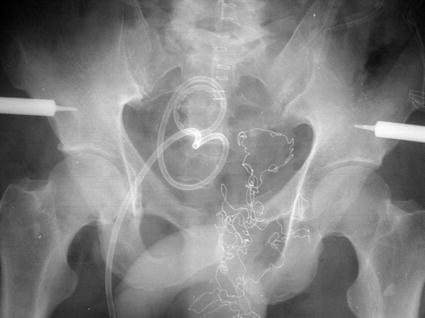Fig. 5.1
Type C pelvic fracture to the left hemipelvis in a hemodynamically unstable 29-year-old man. Standard x-ray of the pelvis in the emergency room shows right sacral fracture, left sacroiliac joint dislocation, and symphysis pubis disruption
In case of an opening pelvic ring disruption, a reduction of the displaced hemipelvis should be performed immediately in the emergency room. The pelvic binder as a T-Pod is very simple to apply, is rapid, and stabilizes and reduces the pelvic volume. T-Pod must be removed within 24 h to avoid pressure sores on the patient.
Surgical treatment in the multiply injured patient in critical condition is performed with external fixation. External fixation of the pelvis has been demonstrated to temporarily stabilize an unstable pelvic fracture and effectively restore pelvic volume, thus improving survival. The application of external fixation has become a resuscitative tool that should be applied as soon as possible. Two main techniques are available to externally fix the unstable pelvic ring: external fixator and C-clamp. The external fixator is indicated in type B fractures, especially open-book type injuries. Pins (at least two on each side of the pelvis) are placed into the iliac crest behind the anterior-superior iliac spine. This placement is safe and easy, and an image intensifier is not necessary.
An absolute indication for external fixation is a severe open pelvic fracture with abdominal lesion that requires colostomy in order to prevent serious infection of the wound and promote rapid healing.
In unstable type C injuries, the pelvic C-clamp (Fig. 5.2) is recommended. The pelvic C-clamp, introduced by Reinhold Ganz [9] 20 years ago, is a device with two pins applied posteriorly in the area of the pelvis lateral to the sacroiliac joints. The pelvic C-clamp is applied quickly, about 15 min, and stabilizes the pelvis, decreasing effectively its diameter (Fig. 5.3). Most importantly, it does not interfere with the ability to perform subsequent laparotomy or other surgical procedure. The pelvic C-clamp may not be used in the presence of iliac wing fracture [9]. Pelvic C-clamp must be removed within 72 h because it is no longer useful and starts to mobilize.



Fig. 5.2
The pelvic C-clamp is applied in the emergency room to stabilize the pelvis

Fig. 5.3




Standard x-ray of the pelvis after application of the clamp shows the restoration of the pelvic ring and stabilization of the patient, who survived after laparotomy
Stay updated, free articles. Join our Telegram channel

Full access? Get Clinical Tree


